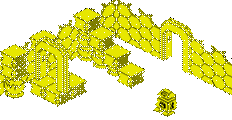Atari Lynx
Vital Statistics
Introduced
1989 |
|
![]()
The Atari Lynx was the world's first ever handheld colour video game system. It had a 3.5" colour backlit LCD screen capable of displaying 16 colours simultaneously from a large palette of 4096 colours. It had 2 fire buttons, 2 'option' buttons, a pause and power button and an 8-way directional pad. It was also unique in that it could be flipped 180 degrees to allow players who preferred the D-pad on the right to use it like that, effectively upside down. It also had hardware support for zooming, distortion and tilting of its sprites, providing pseudo-3D support to games and a capacity for drawing filled polygons with limited CPU intervention. Originally conceived and designed by the games company, Epyx in 1987, they sold their design to Atari, realising they didn't have the finances to launch the product. Almost as soon as it was launched, Atari miscalculated demand for their new hand-held unit, and their fortunes turned bad when they missed the all-important Christmas shopping season due to shortages of stock. Sales remained strong, however, and in the following year (1990), sales of the Lynx doubled. On release in 1989, five games were available: California Games, Blue Lightning, Electrocop, Gates of Zendocon, and Chip's Challenge. Caught in a console war with the Nintendo Game Boy which was released just 1 month earlier at just $90, and NEC's TurboExpress, the Lynx battled through 1990, and in order to keep sales buoyant, in 1991 Atari dropped the price to just $149 for a package deal or $99 for the console alone (see the advertised comparison at the bottom). At the same time, they announced plans to release a smaller, lighter Lynx. Lynx II
All Lynx's had the capability of "linking up" via a communications interface called the ComLynx. This was a comms cable that enabled Lynx owners to connect up to 18 Lynx units together and play "Lynx up" games together. The Lynx I came bundled with the cable, but Lynx IIs didn't. Overall, 36 titles out of 75 official Atari titles supported multi-player via ComLynx. In May 1991, Sega launched their Lynx competitor, the Game Gear. Whilst the Game Gear had shorter battery life, it was supported by many software titles from the outset. This meant that through 1991 the Lynx market share was falling against the Game Boy and Game Gear. By 1994, sales of the Nintendo's Game Boy had far outstripped the Lynx's, and Atari announced they would cease support of the Lynx, focussing their attention on new projects, including the forthcoming Atari Jaguar.
Despite Atari's decision to drop the Lynx, its popularity continued through support from developer Telegames right through the 1990s, including a port of Raiden and a platform game called Fat Bobby in 1997. In 1999, Hyperdrome was released as the last commercial release. Hasbro, who then owned Atari released the rights to develop games for the Lynx to the public domain. Since then, a number of independent developers released games into the new decade, like Championship Rally, CyberVirus, and Alpine Games. Some of the late 90s/early 2000 games were under development by other companies at one time, but rights to the game programs and all of the existing code was bought and finished by other developers.
An Atari advertisement comparing the Lynx to other consoles
During its production lifetime, Atari released a number of accessories for the Lynx including:
From left: Sun Visor/Screen Guard, Carry Pouch, Carrying Case, ComLynx cable, Battery Pack, and Car Adaptor |
Atari Lynx News |












 The original Lynx was criticised for having poor battery life (approx. 4 hours of playing time from Alkaline batteries, or 1.5 hours for Ni-Cd rechargeables). So Atari went to work again, and came up with the "Lynx II", released in July 1991 - a smaller, lighter unit which took less power to run (15% reduction), and the cartridge slot was made to fit the cartridges more easily. It had rubber hand grips and a clearer backlit LCD with a power save option which turned off the LCD panel's backlighting. The Lynx II also got stereo sound through its headphone jack. At the same time, the Lynx cartridges themselves evolved - the earlier cartridges were flat and designed to be stackable, but they were difficult to remove from the console after insertion. The newer cartridge style got a curved lip on the underside.
The original Lynx was criticised for having poor battery life (approx. 4 hours of playing time from Alkaline batteries, or 1.5 hours for Ni-Cd rechargeables). So Atari went to work again, and came up with the "Lynx II", released in July 1991 - a smaller, lighter unit which took less power to run (15% reduction), and the cartridge slot was made to fit the cartridges more easily. It had rubber hand grips and a clearer backlit LCD with a power save option which turned off the LCD panel's backlighting. The Lynx II also got stereo sound through its headphone jack. At the same time, the Lynx cartridges themselves evolved - the earlier cartridges were flat and designed to be stackable, but they were difficult to remove from the console after insertion. The newer cartridge style got a curved lip on the underside.





